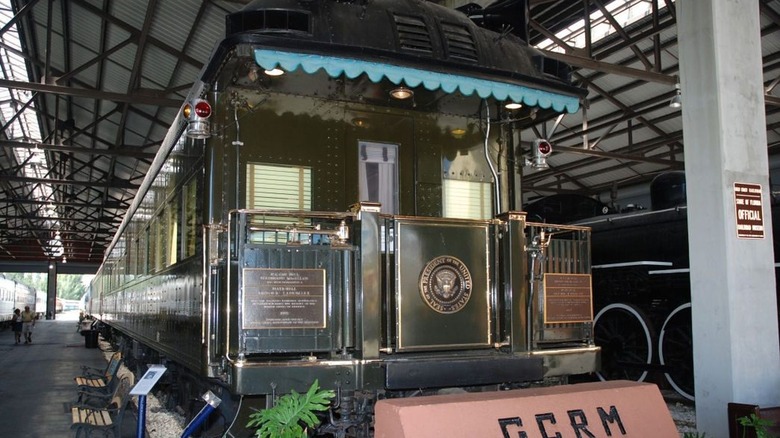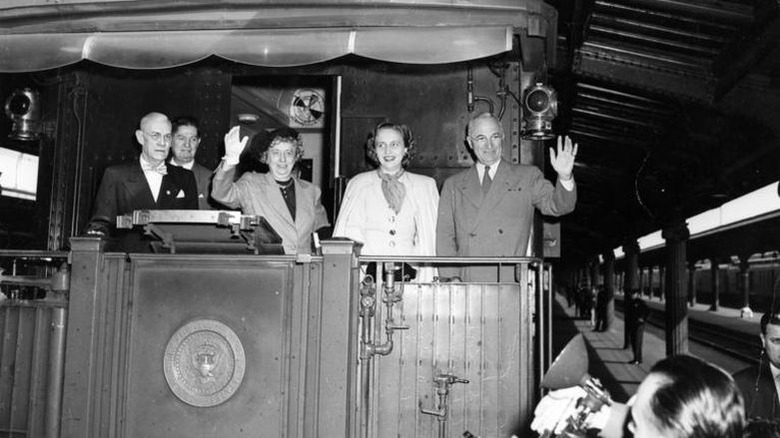The Most Incredible Features Of The Only Presidential Railcar
Back before the President of the United States could climb aboard and fly the friendly skies in Air Force One, there was the Ferdinand Magellan presidential railcar, also known as U.S. Car Number 1.
The story of the only private coach railroad car built for presidential use began not long after the U.S. entered World War II in December of 1941. Secret Service agent Mike Reilly and Stephen Early, White House Press Secretary, advised President Franklin D. Roosevelt that an armored vehicle was needed to better protect and facilitate his travels around the country during a war. Roosevelt initially balked at the idea, but when informed that it would also be used to protect future presidents, he gave his approval.
The Pullman Company originally built the Ferdinand Magellan in 1928 as one of six other luxury railcars named after famous explorers. Once authorized, Pullman went to work retrofitting the 84-foot-long, 15-foot-high, and 10-foot-wide train car (via National Park Service).
The 80-ton (160,000 pounds) car originally came with six rooms, but two were consolidated to make the presidential suite (via Culture Trip). Additionally, there were two guest rooms, a dining room/conference room, and the observation lounge at the back of the car. The lounge was created by removing one of the original staterooms. Each room had a telephone, and the entire car was "air-conditioned" by blocks of ice with fans blowing the cold air around the compartments. Pullman even customized the president's bathroom with a cigar holder because Roosevelt liked to light up a stogey while cleaning up.
A train car worthy of a Bond film
Pullman really got to work by adding an additional 125,000 pounds worth of security features to the Ferdinand Magellan. First, it put 5/8-inch-thick bulletproof steel on all the areas (roof, floor, and sides) where the president stayed. It also installed 12-ply, 3-inch-thick laminated glass in many of the windows. Two escape hatches were installed in case the president needed to be extricated in an emergency. One was located in the bathroom where the window would have been and a second on the lounge's roof, fashioned from a submarine (via Tom Scott's Amazing Places).
The Ferdinand Magellan was the heaviest U.S. railcar ever built when it was presented to Roosevelt, even needing special trucks to accommodate the weight. Pullman had to keep the car at 285,000 pounds because that was the limit allowed on bridges and trestles at the time.
U.S. Car Number 1 traveled with other White House railcars, including ones for staff quarters, offices, medical, and communications. Even the Presidential Limousine and Secret Service Cadillacs hitched a ride inside a garage car (via Atlas Obscura). The entire string was so heavy it often needed two locomotives to get it up steeper track grades.
The president's train car was never painted red, white, and blue, as it kept the original Pullman green. They even removed "Ferdinand Magellan" from the side of the car, which further helped to hide it in plain sight (via National Park Service).
All aboard the campaign train!
In the simpler times of the 1940s — before every house had a television — the Ferdinand Magellan was also pivotal in reelection campaigns. Keep in mind America's very first scheduled television broadcast had just taken place at the 1939 World's Fair in New York City, so TV was a new extravagance that very few people could afford. In fact, Roosevelt was the first president to appear on television during that World's Fair broadcast.
To reach out and touch the people quickly, Roosevelt (and then Harry S. Truman) went on campaign trips, state business, and personal trips via train. Roosevelt traveled some 50,000 miles in the Ferdinand Magellan during his 12 years as president (via Atlas Obscura).
When Roosevelt died suddenly in April of 1945, Truman was forced to take up the mantle of President. He used it for a few more years, most notably for his 1948 "whistle-stop" campaign, where he stopped at towns and cities along the tracks to give brief and raucous rally speeches. In total, he traveled over 31,000 miles and made 356 speeches from the back of the train (via National Park Service).
However, time moved on, and so did technology. Eventually, Truman stopped using U.S. Car Number 1 in favor of modern aircraft like the "Sacred Cow" and, later, "Independence," predecessors of Air Force One.
The Ferdinand Magellan is now housed at the Gold Coast Railroad Museum in Miami, Florida, where guided tours are available.

